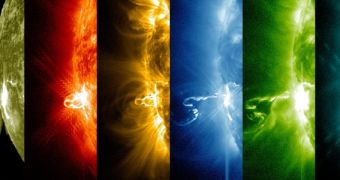Astronomers operating the NASA Solar Dynamics Observatory (SDO) have just released this amazing new image of an intense solar flare that occurred on the surface of the Sun on Monday, February 24.
The event, an X4.9-class flare, peaked at around 7:25 pm EST (0025 GMT today). When it comes to cataloging solar flares, X-class events are the most energetic our Sun is capable of producing. The number following the X denotes how intense the blast was.
For example, an X2 event is two times more powerful than an X1 one, and so on. At this point, experts are still unsure as to whether or not the effects of the most recent blast will affect our planet. The Space Weather Prediction Center at the US National Oceanic and Atmospheric Administration (NOAA) has yet to release any advisories related to this flare.
Earth is protected against the harmful radiations released during such blasts by its magnetosphere, but this does not mean that no negative effects can occur. With sufficient strength, the massive cloud of radiation and charged particles that was produced yesterday can affect satellites and power grids, as well as the International Space Station.
The photo above shows the magnitude of the blast. It is a collage of images collected by SDO at different wavelengths, from 1,600 to 131 Angstroms.

 14 DAY TRIAL //
14 DAY TRIAL //